Can Nature Reclaim Iowa?
Some dream of rewilding one of the most abused states in the nation
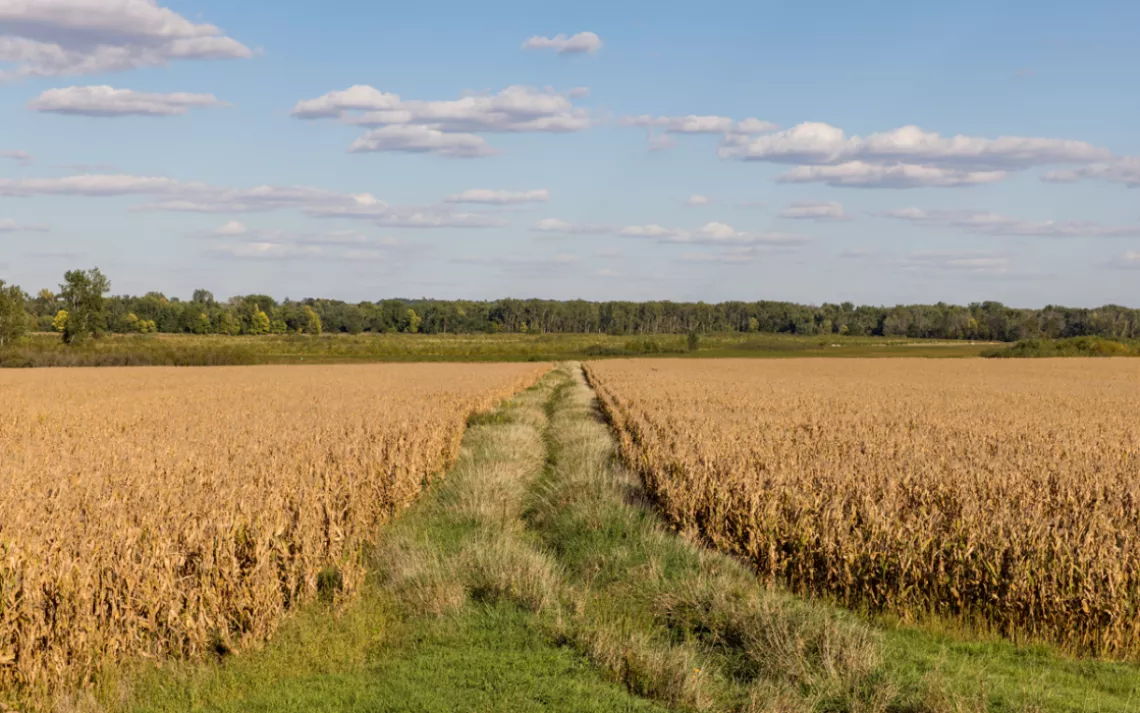
Cornfield in Iowa
IOWA IS a surprisingly hilly state with an unsurprising abundance of corn. In high summer, tightly packed stalks rise overhead and roll out in waves of uniformly stippled green. Every so often, a white farmhouse or a silver grain silo interrupts this monochrome view. There are also billboards—most promote varieties of seed; many condemn abortion; some warn of government land grabs.
Land is political—especially so in Iowa. Today, 85 percent of Iowa's land is used for agriculture. Farmers produce more corn, soy, and pigs here than in any other state—a dominance that has taken a heavy toll. Since 1850, nearly seven inches of nutrient-rich glacial topsoil have been lost to erosion. Growers now compensate with what the industry calls "soil enhancements"—fertilizers that drain off fields and wreak havoc on groundwater and wetland biodiversity. A steady stream of herbicides and pesticides adds to the pollution. According to the Department of Natural Resources, the water in more than half the state's lakes and rivers is unsuitable for swimming, fishing, or drinking.
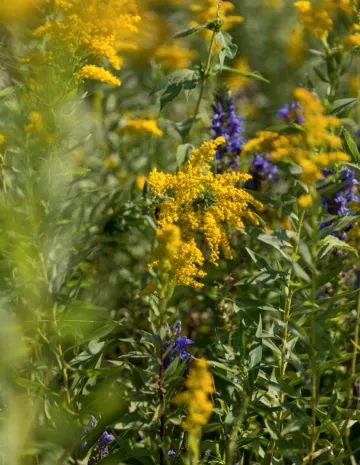
In one of the most used and abused states in the nation, a small but growing number of conservationists have advanced a radical theory: Iowa is ripe for rewilding.
"The solutions exist," Leland Searles said. "It's a matter of allowing the solutions to happen." Searles is a restoration ecologist who spends his days stabilizing stream banks and his nights dreaming of Iowa before the plow. For him, the state is ground zero for the movement to return wildness to the Midwest. He helps organize a network of volunteers, called BeWild ReWild, to spread that gospel.
As a way of healing deeply scarred landscapes, however, rewilding is no easy solution. Whereas ecological restoration often works from the ground up on selective parcels to re-create how a place once appeared, rewilding approaches the problem at the top of the food web by reintroducing extirpated species, especially large carnivores, across huge areas. Often, that means setting aside vast tracts of land for nature to run its course with little human intervention. Gradually, the theory goes, roaming predators will usher in the myriad natural functions that constitute what we call nature.
This is not necessarily a new idea, but with so few real-world trials, the concept still seems aspirational, especially in the Midwest. Dave Foreman, the Earth First! cofounder who coined the term rewilding more than 20 years ago, saw its future in the continent's major mountain ranges and northern boreal forests. "It is simply common sense to acknowledge that wolves are not soon going to be chasing bison across Iowa or north Texas, no matter how much we may dream," he wrote in 2004.
Indeed, today's most ambitious rewilding experiments are happening outside the United States. In Europe, farmers and landowners have pledged to set aside hundreds of thousands of hectares for wildlife to slow species collapse. Wolves have already been reintroduced into Germany and lynx into Spain. In South America, Conservación Patagonica is rebuilding native biodiversity on 650,000 acres of overgrazed Chilean and Argentine ranchlands.
In the United States, conservationists have succeeded in returning wolves to the Rockies and fishers to the North Cascades. Some environmentalists dream of reintroducing jaguars to the Southwest and grizzlies to California. The Great Plains are notably omitted from these schemes because the region is so unfit for the traditional rewilding model. Predators need plenty of food and lots of space, or habitat cores, and they need avenues, or corridors, to spread out and follow migrating prey. These three c's—corridors, cores, and carnivores—underlie rewilding theory and are usually found in less-developed states like Montana, Wyoming, and Utah.
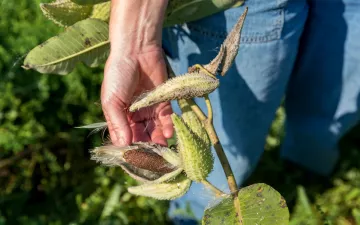
Searles is not dissuaded, nor is he preoccupied with decades-old concepts. In practice, rewilding is a mutable theory whose strategies and outcomes are entirely site dependent. BeWild ReWild's volunteers might dream of wolves chasing bison beyond Interstate 80, but reintroducing carnivores is only part of their vision. Just as critical is convincing people to relinquish control so that nature may pursue its own course. This hands-off approach is rooted in a spiritual environmental ethos, but Searles also points out that it can be cheaper than restoration across large areas. And, by not trying to re-create a past or dictate what wildness means for an ecosystem, rewilding is a tool uniquely suited to a world undergoing rapid change toward some unknowable future.
Most of his daily work seeding native plants and making streams bend again might more closely resemble common restoration than rewilding, but it's all part of a larger vision. "Forty-six acres at a time is a drop in the bucket compared to what needs to be done," he said. Still, "restoration in strategic locations can advance what we'd like to see as far as rewilding."
And what Searles and his fellow rewilding proponents would like to see is the wildest thing of all: a natural corridor that follows the Mississippi and Missouri Rivers from Canada to the Gulf of Mexico, teeming with apex predators, native prairie, keystone species, and human beings liberated from the limitations of anthropocentrism.
Corridors
Kelly Madigan lives in a century-old farmhouse surrounded by hills near the eastern banks of the Missouri River. Although she doesn't purport to be a scientist—she's a poet—Madigan has a unique perspective on rewilding. In November 2020, she walked the length of Iowa's best remaining natural corridor. She completed it in about six weeks, a section at a time, often returning home to sleep in her own bed. "I'm a slow walker," Madigan said.
The path she chose was 270 miles long, leading south through the Loess Hills, which run in a narrow band along the Missouri and contain the state's largest remaining tracts of native prairie. In the evenings, she heard whip-poor-wills and bullfrogs. In the afternoons, she saw butterflies that exist nowhere else and counted more bugs than she'd ever seen in the tilled rows below. When grass goes to seed, it feeds mice, and mice draw snakes. "That's something you don't find in corn," she said. Today, some 20,300 square miles of Iowa have been planted with nothing but corn, while native prairie has been mowed down to less than a half of 1 percent of its precolonial extent.
The hills are made from loess, or windblown glacial silt, which happens to provide an exceptionally rich, arable soil. On the eastern banks of the Missouri, it is piled several hundred feet high, but the same stuff underlays most of Iowa. This explains why so much of the state was quick to go under the plow. At one time, shortgrass and tallgrass prairie covered 45,000 square miles, or about 80 percent, of Iowa. The prairie is a complex community rooted in grass and includes 100 other species of plants, some of which reach 20 feet belowground and hold soil in place. Up above, they provide food and shelter for moths, beetles, crickets, birds, and grazers like deer, pronghorn, elk, and bison. In June, the grassy ridges are abloom with purple prairie clover, scarlet cowboy's delight, yellow ten-petal blazing star, and white snow-on-the-mountain. Lower, in steep ravines, thick oak and hickory coalesce into a canopy as dark as a rainforest's.
Madigan walked to immerse herself in this rare wildness, but in the process she discovered a path that other animals could follow from the expanses of South Dakota to the forests of Missouri and beyond. In the vision for a rewilded Midwest, Iowa can serve as either an avenue or a roadblock; in walking, Madigan proved that it can be the former. If linked with other wild outposts, the Loess Hills could sprout tendrils of biodiversity that thread their way to pockets of refugia all across the state.
To that end, Searles and BeWild ReWild have mapped more than 12 million acres of prime connectivity—mostly slopes too steep for farming and river valleys that frequently flood—and are advocating for their preservation. In those places, letting nature run wild would do little to affect crop yields but could slow erosion, absorb runoff fertilizer, and even buffer fields from flooding. Government easements offered through the national Wetlands Reserve Program are intended to do just this, but enrollment is low and the program has never been fully funded. Instead, many farmers choose to plant unproductive acres and claim insurance payouts on lost yields. "There can be definite gains from those ecological services, but the attitude is 'We've done it this way forever, so why would we change?'" Searles explained.
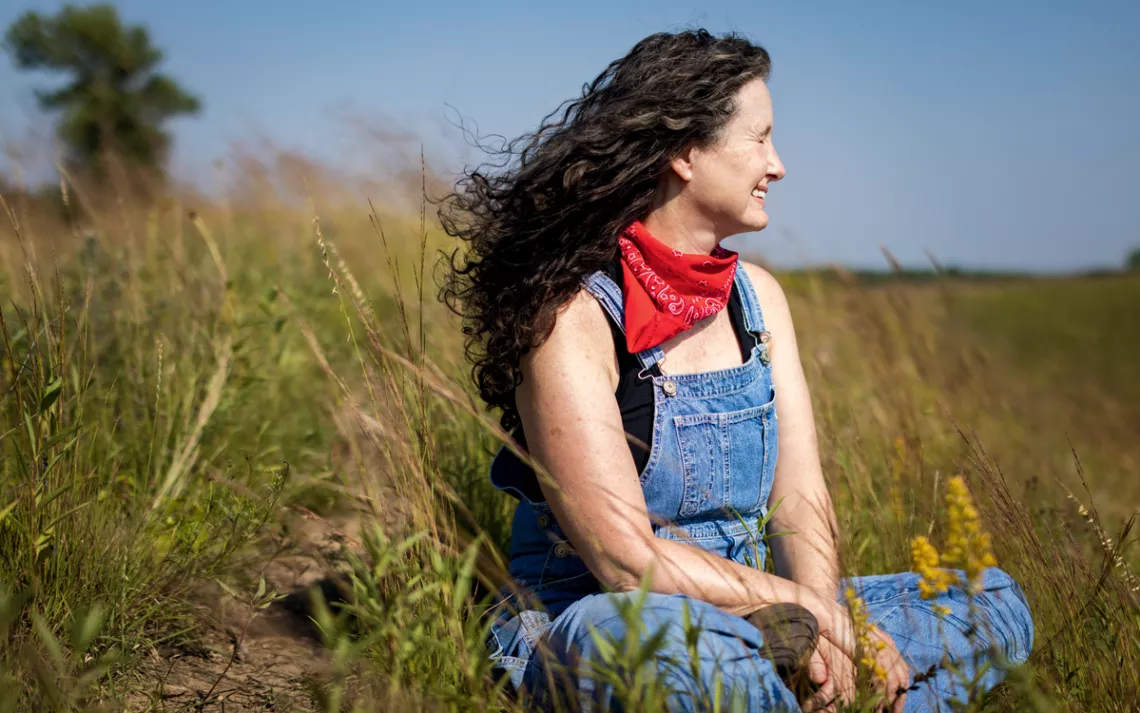
Kelly Madigan at the Loess Hills Scenic Overlook
To achieve this vision, BeWild ReWild will need to connect sparse cores of habitat in a state that is 97 percent privately owned. This is already happening, slowly, with private landowners taking the lead: in the hills around Madigan's farmhouse; on 400 acres of once-productive pasture and crops outside Des Moines that an agribusinessman has let run wild; on a couple's creekside wetland, untouched for 37 years, that now harbors five beaver dams.
To bring fellow Iowans on board, BeWild ReWild has presented its vision at local events and to organizations like the Iowa Environmental Council. Its volunteers have convened writers' workshops, held exhibitions of related work by Native artists, produced short films, and written op-eds for local papers—all in the hope of capturing the imagination of landowners like Madigan, who is returning her generations-old farm to original prairie. Her walk helped her discover how her home fits into the bigger picture. Now, she leads group hikes through the hills to share what she learned and to raise awareness about the threat of development and loess mining. (Bulldozers cart away tons of the coveted soil from a quarry near her home for building foundations.)
But not everyone wants a wild Iowa. At Monona County community meetings where Madigan shared her story, some of her neighbors resented calls to protect the region or encourage public access. The median household income there is just over $47,000, and family legacies are tied up in landownership. Setting any of the land aside for wild nature is seen as an attack on both private property and a way of life.
Cores
Agriculturalists often respond to environmentalists' criticisms of their practices with a slogan: "Farmers feed the world." It's true, but in the early 2000s—when the federal government mandated that ethanol be added to gasoline to produce cleaner emissions—farmers took on powering it too. Today, about 40 percent of Iowa's corn becomes ethanol fuel, and this new market's potential has encouraged intensive planting on every available acre.
"It's becoming harder and harder to create public land," said Joe Jayjack, communications director for the Iowa Natural Heritage Foundation, which purchases acreage to protect natural and cultural heritage all over the state. Although animosity about land grabs is nothing new—Iowans burned derelict railroad bridges in the 1980s to keep them from being made into trails—there are renewed efforts to keep land private. In an extension of political anxieties around the threat of eminent domain, the Republican legislature has been working to block the state's Department of Natural Resources from buying land at auction from farmers who are ready to hang up their hats.
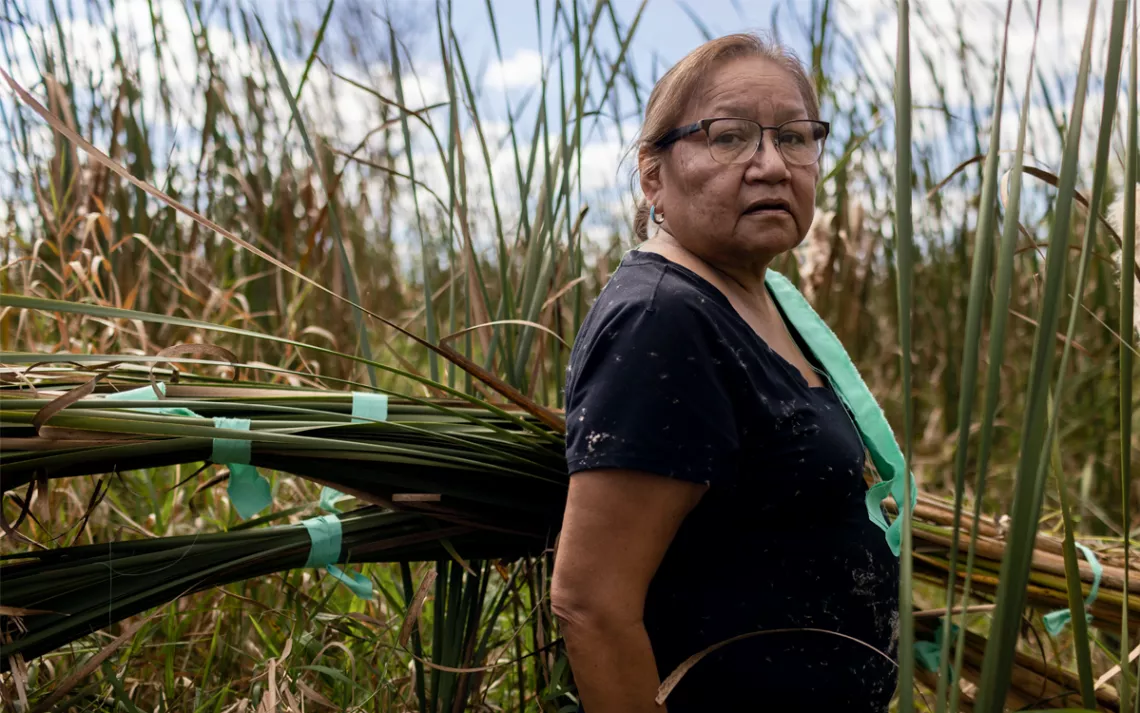
Mary Young Bear holds cattails harvested from Otter Creek Lake and Park.
The INHF, though, is nimbler than a state department. It can purchase and hold properties while the DNR readies funds. The foundation also guides landowners in putting remnant or restored prairie, wetland, and woodland into easements and funds their restoration efforts. "We've been doing rewilding work since we were founded," Jayjack said, "even if we never called it that."
At the Whiterock Conservancy, a 5,500-acre nonprofit land trust an hour west of Des Moines, land manager Carissa Shoemaker pointed out another factor in the case for rewilding: Iowa's ongoing drought. "It's most notable on our agriculture land. The prairies are more resilient."
In 2004, the Garst family gifted Whiterock—once a seed farm that generated enormous private wealth. It was one of the largest such land transfers in Iowa's history. Today, a nonprofit conservancy manages about 2,000 acres of sustainably managed pasture and row crops, 3,400 acres of native prairie and oak forest, and 40 miles of trails. The diversity of those uses is what drew Shoemaker here. "It's trying new things in a place that's suspicious of change, to say the least."
In the shade of gnarled "wolf" oak trees, Shoemaker pointed out burn marks and explained how she uses fire to uncover the land's past. She still guides restoration but is less interested in the idea of reconstructing how the land used to be than in returning its lost ecological functions. "We burn to see what comes back," she said. Most of the time, what sprouts from the ashes are native oaks and bunchgrass.
Whiterock has also tried setting goats loose to fill the role of lost grazers in a small example of rewilding. And the property maintains a small herd of bison, without which no North American grassland is truly whole.
Asked how Whiterock fits into grander visions of rewilding, Shoemaker replied, "It's odd to be somewhere where you're so contained. We have some of the wildest land in Iowa, but it's on an island surrounded by agriculture. So, does this count?"
Hedged in though it is, the property serves as a seed bank for a dwindling prairie ecotype and provides enough space for bobcats, prairie skinks, and coyotes. Visitors have even stumbled upon deer carcasses that might have been left by cougars. If big cats can find their way to Whiterock, Iowa may yet have wild potential.
Not everyone agrees that the way to foster that wildness is to stand back and watch. Karen Viste-Sparkman is a biologist at the Neal Smith National Wildlife Refuge, home to one of Iowa's largest bison herds. She agrees with the goal of rewilding but is not sold on the method. "We are part of nature, like it or not, and we need to act responsibly," she said. "Sure, ecological restoration can be expensive, but it will be more expensive in the long run to do nothing. We need to clean up our mess instead of just putting it aside and forgetting about it."
Carnivores
The last wolf that found itself in Iowa was shot dead less than 20 miles from the Minnesota border. That was in winter 2016, and it seems unlikely that the state—or its pig farmers, ranchers, and dairy farmers—have grown more accepting of large carnivores since. Neighboring Wisconsin, Minnesota, and Missouri harbor healthy populations of black bears, though, and the DNR has said that Iowans should not be surprised to see resident cubs in the next three to five years.
Black bears are native but have been missing for so long that they don't appear in the state's wildlife-management laws. There have been only 43 sightings since 2002. Returning them could help buffer other species from the impacts of climate change, according to research published in the journal Conservation Biology in 2021. By attracting carrion and keeping herbivores on the move, predators play a central role in a web of relationships and feedback loops that create ecosystem resilience. They pave paths for the migratory trickle of animals driven on by rising temperatures and shifting seasons.
Yet there are few issues here as polarizing as the reintroduction of large predators. They were dispatched as competition soon after European colonists settled the state in the mid-1800s. Overcoming that prejudice will require a seismic shift in thought—a rewilding of the mind, some say.
Mary Young Bear is the historical preservation conservator for the Meskwaki Nation, Iowa's sole federally recognized tribe. Years ago, she traveled to Michigan and Oklahoma to learn traditional mat weaving from tribes that had learned the practice from her own ancestors before it was lost to epidemics and the grind of industrialized progress.
"Before that, all we had were books and pictures," she said. Now, she's committed to bringing weaving back, not just as a hobby but as a functional part of everyday life on the tribal settlement.
The Meskwaki people originally lived in what is now called the St. Lawrence River valley along the Canadian border. Pushed westward by colonists and other tribes, they kept close to rivers where they could find bulrushes and cattails. They lived in domed huts, called wikiups, that they covered with mats woven from these riverbank reeds.
In 2019, Young Bear held a two-day workshop teaching mat weaving to more than 100 other tribal members using a grant she received from BeWild ReWild. It was the first time an outside group had supported her effort, and though her tribe's relationship with the group has continued, Young Bear said that the Meskwaki have their own perspective on wildness and their own role to play in its future in Iowa.
The Meskwaki Nation purchased its first piece of land, around 80 acres, in 1857. That land expanded to more than 8,000 acres and now includes a casino, a commercial farm, a bison herd, a prairie restoration effort, and a food sovereignty project. As in Monona County, the nation's legacy is tied up in the land, but the Meskwaki can recall a time when the obligation felt reciprocal.
"Our existence is just cohabitating alongside nature. We have mutual respect," Young Bear explained. She stood beside hanging mats that had been woven from five-foot-tall bulrush reeds and bound with bison-bone needles. Harvesting the reeds in August and weaving as a group are ceremonies that maintain the Meskwaki's bond with the wild land, she said. Intimacy breeds trust.
Young Bear said that the movement to heal a degraded land and rekindle a lost relationship is the most important work she has ever been part of. But she doesn't get caught up in labels like "rewilding."
"I don't know what you want to call it," she said. "For us, it's survival."
This article appeared in the Spring 2022 quarterly edition with the headline "Rewilding Iowa."
 The Magazine of The Sierra Club
The Magazine of The Sierra Club



